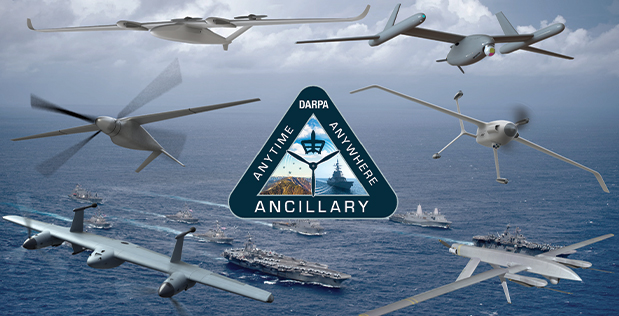DARPA Selects Six Companies To Continue In Long-Endurance VTOL UAS Program

The Defense Advanced Research Projects Agency (DARPA) this week said it selected six companies to continue in the risk reduction and component testing phase of its program to develop vertical take-off-and-landing (VTOL) uncrewed aircraft system (UAS) in support of Navy and Marine Corps missions.
The mix of traditional and non-traditional defense contractors selected include AeroVironment, Griffon Aerospace, Karem Aircraft, Method Aeronautics, Northrop Grumman, and Lockheed Martin’s Sikorsky business unit for Phase 1b of the AdvaNced airCraft Infrastructure-Less Launch and RecoverY program, what DARPA calls ANCILLARY. The Phase 1a effort also included AVX Aircraft, Leidos, and Piasecki Aircraft.
In the 10-month Phase1b, DARPA said the companies will mature their X-plane designs to reduce risk by conducting component and configuration hover testing. Sikorsky on Wednesday said it is already doing flight tests using a battery-powered proof-of-concept vehicle to “prove the efficiency and scalability of a twin proprotor ‘rotor blown wing’ configuration that sits on its tail to take-off and land like a helicopter, and transitions easily to horizontal forward flight for long-endurance missions, such as intelligence, surveillance, reconnaissance and targeting.”
At the end of Phase 1b, companies will submit competitive proposals for Phase II, which includes detailed design, fabrication, and testing, DARPA said. The program will end with flight tests beginning in early 2026.
DARPA wants designs that can launch and recover from ships without “large mechanical launchers” or special landing equipment typically in use today, it said. Another requirement is to be able to operate from remote, unprepared land locations in most weather conditions and fly like winged aircraft with a significant payload as needed.
“The goal of ANCILLARY is to increase small vertical take-off and landing uncrewed aerial system capabilities by a factor of three over the current state-of-the-art flying today,” Stevn Komadina, DARPA’s program manager, said in a statement, “Our performers are searching for innovative ways to increase payload weight and range/endurance of small, ship-launched UAS by means of novel configurations, propulsion, and controls while also removing the need for special infrastructure.”
Northrop Grumman said the Phase 1b selection moves it a “step closer to building a flight demonstrator.” The company said its teammates include Leigh Aerosystems and Near Earth Autonomy.
Igor Cherepinsky, director of Sikorsky’s rapid prototyping group, said in a statement about his company’s offering that “Key enablers to flight maneuverability, and future vehicle scalability, are our MATRIX autonomy flight control system, and an articulated rotor system similar to those in traditional helicopters.”
If Sikorsky is selected for Phase II, the company said it will build a 300-pount hybrid-electric version of its UAS that includes a 60-pound ISR payload.
DARPA received $13.2 million for ANCILLARY in fiscal year 2024 and is requesting $22.9 million for the program in FY ’25.
A version of this story originally appeared in affiliate publication Defense Daily.
The post DARPA Selects Six Companies To Continue In Long-Endurance VTOL UAS Program appeared first on Avionics International.
—————
Boost Internet Speed–
Free Business Hosting–
Free Email Account–
Dropcatch–
Free Secure Email–
Secure Email–
Cheap VOIP Calls–
Free Hosting–
Boost Inflight Wifi–
Premium Domains–
Free Domains





